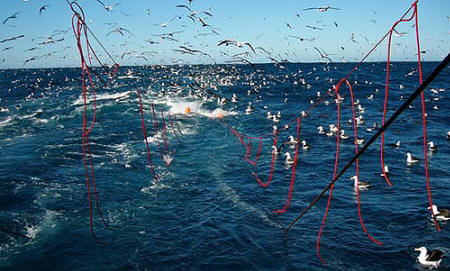In November last year Namibia gazetted separate regulations to protect seabirds in its demersal longline and demersal trawl fisheries for hake Merluccius spp. The Minister of Fisheries and Marine Resources the Hon. Bernhard Esau, MP made the regulations on 18 August 2015 in terms of Namibia’s Marine Resources Act, No. 27 of 2000.
For longline fishing at least one bird-scaring line (BSL) must be deployed at all times during fishing operations. The regulations give detailed information on line design and deployment, including when paired BSLs are deployed.
Two bird-scaring lines have to be deployed by trawlers when fishing. Again, information is given in the gazetted notice on design and deployment.
The regulations came into force from 30 November 2015; contraventions may incur both fines and imprisonment.

Twin bird-scaring lines deployed behind a South Atlantic trawler keep Black-browed Albatrosses away from the warps
Photograph by Barry Watkins
ACAP’s Fifth Session of its Meeting of Parties in the Canaries on the island of Tenerife last year in May heard from the Namibian Observer present that progress was being achieved in Namibia to becoming a Party to the Agreement, with the possibility this might happen in the near future (click here).
With thanks to Hannes Holtzhausen for information.
Reference:
Government Gazette of the Republic of Namibia 14 November 2015. No. 5877. Notices 269 and 270. 6 pp.
John Cooper, ACAP Information Officer, 26 January 2016

 English
English  Français
Français  Español
Español